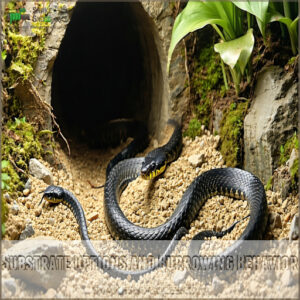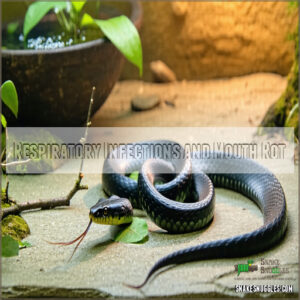This site is supported by our readers. We may earn a commission, at no cost to you, if you purchase through links.

Start with a secure 20-gallon enclosure featuring a warm side (85-90°F) and a cooler side (75-80°F).
Use hides and décor to mimic their natural environment and keep them happy.
These snakes thrive on a diet of frozen-thawed rodents, fed every 10-14 days—just pick prey that matches the snake’s girth.
Their glossy black scales and gentle temperament make handling a breeze, but remember to look for signs of health like bright eyes and active movement.
With proper care, they can live over 20 years—talk about a long-term bond!
Table Of Contents
- Key Takeaways
- Mexican Black Kingsnake Overview
- Enclosure Setup and Environment
- Diet and Feeding Requirements
- Health and Handling Considerations
- Long Term Care and Maintenance
- Frequently Asked Questions (FAQs)
- Are Mexican black kingsnakes easy to take care of?
- How often should you feed a Mexican black kingsnake?
- Are Mexican black kingsnakes bitey?
- How big of a tank does a Mexican black kingsnake need?
- How big do Mexican black kingsnakes get?
- What size cage does a Mexican black kingsnake need?
- How often should my kingsnake be handled?
- What tank size is best for adults?
- How do I train a snake using a hook?
- Can I keep multiple kingsnakes together?
- Conclusion
Key Takeaways
- Keep your Mexican black kingsnake’s enclosure secure, with a warm side (85-90°F) and a cool side (75-80°F), and avoid heat rocks to prevent burns.
- Feed frozen-thawed rodents every 10-14 days, matching the prey size to your snake’s widest part to ensure safe digestion.
- Maintain humidity levels between 40-60% and provide a humid hide with damp moss to support shedding and overall health.
- Handle your snake 1-2 times weekly, staying calm and gentle, and always watch for signs of stress or defensive behavior.
Mexican Black Kingsnake Overview
You’re looking at one of the most striking and hardy snake species, the Mexican black kingsnake (Lampropeltis getula nigrita).
This non-venomous constrictor is known for its glossy black scales and manageable size, and it thrives in captivity with proper care, making it a notable example of a non-venomous constrictor.
Scientific Name and Classification
The Mexican black kingsnake, or Lampropeltis getula nigrita, belongs to the Colubridae family, a diverse group of non-venomous snakes.
Part of the Lampropeltis genus, this kingsnake species showcases fascinating evolutionary history.
Its species taxonomy highlights its genetic ties to other Lampropeltis snakes, and phylogenetic analysis reveals its adaptability, making it a favorite among enthusiasts intrigued by classification systems and snake genetics.
Natural Habitat and Range
You’ll find these snakes thriving in semi-arid regions with rocky outcrops and burrows.
Their geographic distribution spans Mexico’s Sonoran Desert, southern Arizona, and parts of Sinaloa.
Here’s what defines their natural habitat:
- Desert ecosystem with sparse vegetation
- Rocky terrain for shelter
- Warm climates year-round
- Border regions fostering hybrids
- Opportunistic burrowing and swimming behavior
Understanding the mexican black kingsnake habitat is essential for creating a suitable environment in captivity.
Physical Characteristics and Appearance
Glossy, iridescent scales give the Mexican black kingsnake its signature look, shimmering with hints of blue and purple under light.
This striking appearance, paired with balanced body proportions, makes it a favorite among enthusiasts.
The Mexican black kingsnake has a unique morphology, with iridescent scales that add to its fascination, and color morphs, like albino variations, add even more fascination to its unique morphology.
Lifespan and Growth Rate
A well-cared-for Mexican black kingsnake can live 15-20 years, offering plenty of time to enjoy its fascinating growth patterns and aging process.
These snakes grow steadily, reaching 3-4 feet by adulthood.
Key stages include:
- Hatchling: Rapid growth in the first year.
- Juvenile: Slower development.
- Adult: Fully mature by 3 years old.
- Longevity Factors: Proper diet and care.
- Maturity Rates: Consistent feeding guarantees healthy development.
Common Morphs and Color Variations
While most Mexican black kingsnakes sport stunning, jet-black scales with iridescence effects of blue or purple, there’s more to their look.
Albino genetics create pale pinkish-white albino kingsnakes with red eyes, while kingsnake hybrids may showcase unique scale patterns.
Morph breeding has also introduced fascinating color mutations, making mexican kingsnake morphology a favorite among enthusiasts exploring diverse kingsnake morphs.
Enclosure Setup and Environment
Creating the perfect enclosure for your Mexican black kingsnake guarantees its health and happiness.
You’ll need to balance temperature, humidity, and space while providing enrichment to mimic its natural habitat.
Temperature Gradient and Heating Methods
Creating the right temperature gradient keeps your kingsnake comfy and healthy.
Use heating elements like halogen floods or under-tank heaters for basking spots around 85-90°F, with cooler areas at 75-80°F.
Thermostats are non-negotiable for temperature control—overheating’s no joke.
For a thorough care guide, see this Mexican Black Kingsnake resource.
Combine UVB lighting with heat sources for a natural day-night cycle.
Skip heat rocks; they’re accidents waiting to happen.
Humidity Levels and Maintenance Techniques
Humidity control for your Mexican black kingsnake isn’t tricky but needs attention.
Aim for 40-60% humidity using water bowls, misting systems, or substrate moisture adjustments.
A humid hide with damp sphagnum moss works wonders.
Use a hygrometer for accurate readings—calibration is key!
In bioactive vivariums, semi-arid setups with proper airflow keep levels stable.
Balance is the heart of reptile care basics.
Maintaining ideal humidity control levels is essential for the overall health and well-being of your pet snake, and proper humidity management is vital for their well-being, so visit humidity control levels to learn more.
Lighting Requirements and UVB Exposure
Proper lighting keeps your kingsnake thriving.
Use a 2% UVB lighting tube to mimic natural sunlight, paired with basking lamps for warmth.
Maintain a 12-hour photoperiod to regulate their day-night cycle.
Light intensity matters—choose a bulb with the right spectrum requirements like an Arcadia T5.
Good UVB exposure supports health, even though Mexican black kingsnakes don’t rely heavily on UV lighting.
Substrate Options and Burrowing Behavior
Mexican black kingsnakes love burrowing, so substrate depth matters—aim for at least 4 inches.
Kingsnake substrate options like coconut fiber, aspen, or a soil-sand mix mimic their natural habitat.
Keep soil moisture balanced to support digging behavior without sogginess.
Tunnel systems often form naturally, adding enrichment.
Avoid pine or cedar, and consider bioactive setups for a dynamic snake enclosure idea.
When selecting a suitable kingsnake substrate, prioritizing the snake’s health and well-being is key.
Diet and Feeding Requirements
Feeding your Mexican black kingsnake a proper diet is essential to its health and growth.
By offering appropriately sized prey and sticking to a consistent schedule, you’ll keep your snake active, satisfied, and thriving.
Dietary Needs and Prey Selection
In terms of the Mexican black kingsnake diet, variety is key.
These opportunistic feeders thrive on a mix of frozen-thawed rodents, chicks, and lizards.
Follow this kingsnake feeding guide:
- Choose prey matching the snake’s widest part.
- Stick to frozen-thawed options.
- Avoid live prey risks.
- Source from reputable suppliers.
- Rotate prey types for balanced nutrition.
For ideal care, understanding Mexican Black Kingsnake habits is essential to provide the right environment and balanced nutrition.
Feeding Schedule and Frequency
Stick to a regular snake feeding schedule to keep your Mexican black kingsnake healthy and happy.
Hatchlings thrive on meals every 5-7 days, while juveniles need food every 7-10 days.
Adults? They’re good with a 10-14 day cycle.
This kingsnake feeding guide helps balance digestion cycles and snake nutrition, ensuring consistent energy without overfeeding.
Proper Prey Size and Preparation
When planning your Mexican black kingsnake’s meals, choose prey matching the snake’s widest part—too big, and it’s trouble.
This decision is crucial because proper prey size and preparation keep snake nutrition on track.
Thaw frozen prey thoroughly, ensuring no icy spots, and warm it slightly to mimic live warmth, then use feeding tweezers for safety and precision, making this reptile feeding guide a key part of kingsnake care tips.
Avoiding Live Prey and Potential Risks
Feeding live prey might seem natural, but it’s a gamble with your mexican black kingsnake’s safety.
Live rodents can fight back, causing snake injuries.
Stick to pre-killed or frozen prey for safer feeding.
Proper prey storage is key—use a freezer and thaw before feeding.
These kingsnake care tips guarantee a stress-free reptile feeding guide, perfect for snake care for beginners.
Health and Handling Considerations
Keeping your Mexican black kingsnake healthy means watching for signs of illness and understanding its unique needs.
Proper handling guarantees your safety but also helps the snake feel secure and stress-free.
Signs of a Healthy Mexican Black Kingsnake
A healthy Mexican black kingsnake is easy to spot if you know what to look for:
- Vibrant Scales: Smooth, glossy, and free of dull patches.
- Bright Eyes: Clear, not cloudy or sunken.
- Active Behavior: Curious and alert, especially during handling.
- Healthy Appetite: Regularly eating offered prey.
- Strong Musculature: Firm body with no sagging or lumps.
The characteristics listed above are essential in identifying a healthy Mexican black kingsnake, and by following these guidelines, you can ensure that your pet is thriving.
Respiratory Infections and Mouth Rot
Respiratory infections and mouth rot are common snake health issues, but catching symptoms early is key.
Watch for nasal discharge, lethargy, or discolored patches near the mouth.
A vet can confirm with bacterial cultures and recommend antibiotic therapy.
Keep enclosures clean, maintain proper humidity, and avoid pine shavings to prevent infections.
| Symptom | Possible Cause | Prevention Tip | Diagnosis Method | Treatment |
|---|---|---|---|---|
| Nasal discharge | Respiratory infection | Maintain humidity (40-60%) | Veterinary diagnostics | Antibiotic therapy |
| Lethargy | Illness or stress | Proper temperature gradient | Physical exam | Prescribed medication |
| Mouth discoloration | Mouth rot or pigment | Clean water, hygiene | Bacterial cultures | Antibiotic therapy |
| Open-mouth breathing | Respiratory infection | Avoid cedar/pine shavings | Visual inspection | Vet-prescribed care |
| Refusal to eat | Health issue | Stress-free environment | Observation | Vet consultation |
The table outlines specific symptoms, possible causes, prevention tips, diagnosis methods, and treatments for snake health issues, emphasizing the importance of early detection and proper care to prevent complications.
Parasitic Infestations and Prevention
After tackling respiratory concerns, let’s talk parasites.
Snake mites, intestinal worms, and fungal infections can sneak in through food, substrate, or poor hygiene.
Wash your hands, freeze bedding, and sanitize enclosures monthly to keep reptile health in check.
Stick to reputable feeder sources and watch for signs like lethargy or unusual behavior.
Parasite control starts with prevention!
Shedding Problems and Assistance
When your Mexican black kingsnake faces shedding issues, it’s often tied to humidity control or other snake health problems.
Retained shed or scale damage can lead to bigger skin problems if ignored.
Understanding snake shedding problems is essential for effective care.
Here’s how to help:
- Boost humidity with a moist hide.
- Soak your snake in lukewarm water.
- Gently remove stuck shed with damp paper towels.
- Check for mites or infections.
Safe Handling Practices and Body Language
Reading your black kingsnake’s body language is key.
Watch for tail vibrations or defensive postures—they’re like a snake’s “back off” sign.
Use gentle restraint, never grabbing by the tail.
Tap its head lightly with a paper towel before handling to signal “not food.”
| Do | Don’t |
|---|---|
| Wash hands before handling | Handle right after feeding |
| Use feeding tweezers | Grab by the tail |
| Handle 1-2 times weekly | Overhandle or stress them |
| Watch for warning signs | Ignore defensive behavior |
Long Term Care and Maintenance
Caring for a Mexican black kingsnake long term means staying on top of their health and keeping their environment clean and safe.
You’ll need to adjust their care with the seasons and keep detailed records to verify they’re thriving, which involves detailed records.
Regular Health Check-ups and Veterinary Care
Your Mexican black kingsnake’s health isn’t something to gamble with.
Regular vet visits can prevent costly medical emergencies like parasites or infections.
Look for an exotic vet skilled in diagnostic tools for reptile care.
- Check for snake health insurance to ease veterinary costs.
- Stay alert for shedding issues or feeding changes.
- Consider vaccine options carefully.
- Periodic fecal exams catch hidden diseases.
Enclosure Cleaning and Sanitation Practices
Regular waste removal and water bowl maintenance are non-negotiable for a clean enclosure.
Stick to weekly cleaning schedules, using reptile-safe disinfectant for sanitation.
Scrub surfaces and snake care equipment thoroughly.
For specialized cleaning products, explore kingsnake enclosure cleaner options.
Hygiene protocols matter—sanitize tools to avoid cross-contamination.
For bioactive setups, spot-clean often, allowing cleanup crews to handle minor waste.
Consistent enclosure maintenance guarantees a healthy, stress-free environment for your kingsnake.
Seasonal Adjustments to Care Routine
Seasonal kingsnake care means adjusting for Winter Care Tips and Summer Humidity.
During colder months, make certain your Mexican Black Kingsnake habitat stays cozy with a stable temperature gradient.
In summer, watch for excessive humidity that can mess up shedding.
Autumn Habitat tweaks might include slight temperature shifts.
Seasonal Feeding also matters—snakes can slow down in winter, so feed less frequently.
Record Keeping for Growth and Health
Keeping a care journal makes mexican black kingsnake health stay on track.
Use growth charts, weight tracking, and feeding records to notice trends.
Did your snake skip meals or lose weight? Jot it down.
These logs offer insights into reptile nutrition and health. Regular updates simplify kingsnake care while spotting small issues early, saving you big headaches later.
Legal Considerations and Responsible Ownership
Tracking your kingsnake’s growth is rewarding, but don’t skip understanding ownership laws.
Check your state’s permit requirements—some reptiles, like the Mexican black kingsnake, could be restricted.
Responsible pet ownership means sourcing from reputable breeders, following breeding regulations, and respecting conservation efforts.
Prioritize animal welfare in reptile keeping, ensuring proper kingsnake care that aligns with its conservation status and local laws.
Frequently Asked Questions (FAQs)
Are Mexican black kingsnakes easy to take care of?
Mexican black kingsnakes are ridiculously low-maintenance if you stick to their needs—secure enclosure, proper temps, and regular feeding.
They’re hardy, calm, and forgiving, making them one of the easiest snakes to care for.
How often should you feed a Mexican black kingsnake?
Feed your Mexican black kingsnake every 5-7 days as a hatchling, every 7-10 days as a juvenile, and every 10-14 days as an adult.
Stick to prey matching the snake’s widest body part.
Are Mexican black kingsnakes bitey?
They’re not “all bark and no bite,” but Mexican black kingsnakes are calm and curious when handled regularly.
Occasionally, they’ll strike or nip if stressed or startled, so handle them gently and confidently to build trust.
How big of a tank does a Mexican black kingsnake need?
You’ll need at least a 4-foot tank (48x24x24 inches) for an adult Mexican black kingsnake.
They’re escape artists, so make certain it’s secure with no gaps.
Bigger enclosures give them space to explore—always a bonus!
How big do Mexican black kingsnakes get?
These sleek beauties usually grow about 3-4 feet long, though some can stretch closer to 4 feet.
Their manageable size makes them a great choice for reptile enthusiasts without needing a massive enclosure.
What size cage does a Mexican black kingsnake need?
Go for a 48” x 24” x 24” enclosure for an adult Mexican black kingsnake.
It gives them space to explore, climb, and burrow.
Bonus tip: secure everything—these sneaky escape artists love testing boundaries, especially with a 48” x 24” x 24” enclosure.
How often should my kingsnake be handled?
Handle your kingsnake 1-2 times a week to build trust and bond.
Start slow, keep sessions short, and always use gentle hands.
Too much handling stresses them out—think of it like respecting a roommate’s space.
What tank size is best for adults?
Go for a 48" x 24" x 24" enclosure (120 gallons) for adult kingsnakes.
It’s spacious enough for roaming and exploring while preventing escapes.
If you’ve got room, bigger is always better for their happiness!
How do I train a snake using a hook?
Think of hook training like shaking hands—it builds trust.
Start by gently tapping your snake’s head with the hook to signal interaction, not food.
Stay consistent, calm, and patient, letting your snake adjust over time.
Can I keep multiple kingsnakes together?
Keeping multiple kingsnakes together isn’t a good idea.
They’re known for cannibalism and prefer solitude.
Even with enough space, the risk of one eating the other is high.
Separate enclosures keep everyone safe and stress-free.
Conclusion
Picture your Mexican black kingsnake gliding gracefully through its well-maintained enclosure, healthy and content.
With the right care—balancing temperature, humidity, and a proper diet—you’re ensuring a thriving snake for decades.
Pay attention to its health signs, keep up with enclosure cleaning, and embrace the joy of responsible ownership.
From feeding frozen-thawed rodents to safe handling practices, you’ve got everything you need to succeed in Mexican black kingsnake care.
Now, enjoy building that lasting bond!
- https://reptilesandresearch.org/care-guides/mexican-black-kingsnake-care-guide
- https://www.thebiodude.com/blogs/snake-caresheets/mexican-black-kingsnake-care-sheet-lampropeltis-getula-nigrita
- https://www.reddit.com/r/snakes/comments/ym0z5m/enclosure_care_requirements_for_mexican_black/
- https://reptifiles.com/kingsnake-care-sheet/
- https://www.reptilecymru.co.uk/mexican-black-kingsnake-care-guide/


















